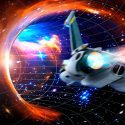Why does the Earth have to be either round or flat? What if there could be a happy middle ground? Welcome to your very own polyhedron Earth. What would this Earth look like? In what ways would this affect our planet’s gravity? And what impact would this have on the continents as we know them?
Polyhedrons come in all shapes and sizes. Anything that has multiple faces joined at their edges can be a polyhedron. Picture Earth as a six-sided cube. Or as a triangular pyramid with four faces known as a tetrahedron. Or even two rectangular pyramids stacked on top of each other. That would be an octahedron.
But there could be one polyhedron that is the best contender for Earth’s new shape. An icosahedron. This polyhedron has 20 identical triangular faces. It could match up perfectly with a map that provides the most accurate version of Earth when displayed on a two-dimensional surface. So if the planet looked like a 20-sided die, what would be the odds that it’s anything like the Earth we live on today?
You’ve probably seen a flat, rectangular map of the Earth. But what you may not know is how distorted these maps can be. That’s because it’s difficult to display the three-dimensional surface of a spherical Earth onto two dimensions. On these maps, Greenland often looks to be almost as big as the entire continent of Africa. In reality, Africa is about 14 times larger.
The Fuller projection map, also known as a Dymaxion map, is a projection of the Earth onto the faces of an icosahedron. Impressively, this map creates no obvious distortions of shapes and sizes of land areas. Only life on an icosahedron Earth would be quite distorted. The most dramatic change you’d notice would be a completely different gravity than what you have today.
Gravity is what makes a planet round in the first place. As it’s forming, a planet is hot and composed of molten material. Since its gravity pulls equally in all directions from its center, it eventually takes on the shape of a sphere. But on a polyhedron Earth, there would be an unequal distribution of gravity. Only at the direct center of each of the 20 faces would you experience what you know as normal gravity.
As you moved toward the corners of each face you’d feel the pull of gravity lessening. Let’s imagine you weigh 90 kg (200 lb) with Earth’s current gravity. Only at the center of each icosahedron face would you weigh this much. On the corners, you could now find yourself weighing in at about 58 kg (129 lb). This unequal pull of gravity would also make a walk from the center of one face to its corner feel more like a hike.
It would get steeper and steeper as you’d go along the enormous mountain corners of our icosahedron planet. Naturally, this would have a dramatic effect on Earth’s oceans. The water would pool toward the center of each individual face creating vast bodies of water in the middle of each. This would leave the edges dry and barren.
The same would happen to our atmosphere. You’d find that the edges would provide minimal protection from the Sun. But isolated in the center would be thick atmospheres capable of preventing harmful UV radiation from reaching the surface. The Dymaxion map could give you the impression that all the continents would fit neatly together on an icosahedron.
As you can see, this new Earth would look very different from the Earth you know. Northern Africa, parts of western Europe and the Middle East would all exist together on one triangular face. South America would be divided across three distinct sides. Canada and Greenland would form one giant landmass. The U.S., on the other hand, would remain largely unchanged.
Well, unchanged might not be the best choice of words. With all those dramatic shifts in gravity, water locations and the atmosphere it would be pretty difficult to recognize the old continents. Earth would now have 20 completely isolated ecosystems at the center of each face. Within each, you could find unique varieties of animals and plants.
You’d have quite an uphill journey through the extremes of the lifeless corners of the Earth just to get to the other faces. A flat Dymaxion map is meant to present a more realistic geographical representation of Earth. Turn it into a fully three-dimensional version and it would end up being quite distorted, to say the least. And that’s before you’d see the effect this would have on the Moon.
Its orbit would be significantly disrupted by the differences in gravity between the centers and edges of each face. Eventually, this could lead to the Moon crashing into Earth. And that would do some damage.
Sources
- “Polyhedron“. Weisstein, Eric W. 2022. mathworld.wolfram.com.
- “Africa Is Way Bigger Than You Think”. Fischetti, Mark. 2015. blogs.scientificamerican.com.
- “What Are Map Projections? (And Why They Are Deceiving To Us)”. 2015. gisgeography.com.
- “What If The Earth Were A Cube?”. Dev Lunawat. 2019. scienceabc.com.
- “Why Are Planets Round?”. 2022. spaceplace.nasa.gov.


























